Liz's Arctic Adventures
Our Polar Operations Manager, Liz Noakes, is currently in the Arctic on our Realm of the Polar Bear in Depth cruise. Sailing for 10 nights aboard the M/S Expedition ship, around the Svalbard Archipelago and Spitsbergen, Liz is sending back daily bulletins of her exciting adventures.
Our Polar Operations Manager, Liz Noakes, is currently in the Arctic on our Realm of the Polar Bear in Depth cruise. Sailing for 10 nights aboard the M/S Expedition (G Expedition) ship, around the Svalbard Archipelago and Spitsbergen, Liz is sending back daily bulletins of her exciting adventures.
Day 1 - A thrilling polar bear encounter...
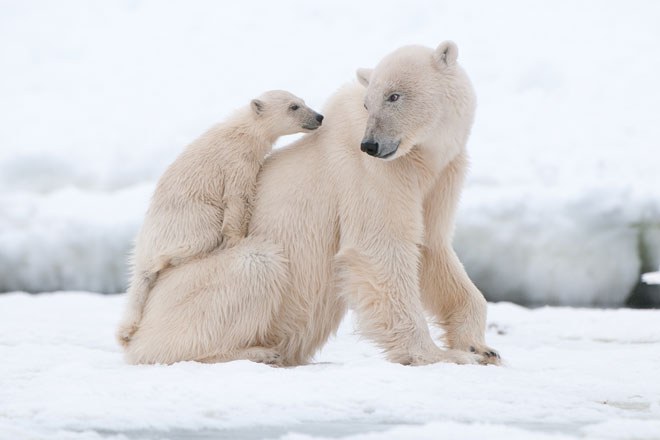
"Day 1 on board has been amazing. After important safety briefings from the crew in the morning we set out on the Zodiac boats for our first shore landing of the cruise. The clouds were low but we could still see the mountains all around us and watch glaciers calving into the sea. As the afternoon wore on the cloud lifted to reveal a host of pointy peaks for which the main island of Svalbard is so aptly named in Dutch, "Spitzbergen".
Before we set off in the Zodiacs, a group of the very professional staff zoomed out to check the shoreline for bears and, having had the all clear, we loaded into boats and headed for shore. After a walk along the coast, marveling at the different colours of ice in the glacier ahead that was tumbling down the mountain into the sea, we reached a sandy beach with an interesting array of jetsam - apples, oranges and watermelon rind! This was to prove significant later.....
We then drove round the bay in the Zodiacs watching the glacier calving and arrived at another beach with a pile - literally - of walruses snoozing away. Quite a sight and smell! Many photos later we left for a closer look at some of the pieces of ice bobbing around in the sea and listen to the 'popping' as air bubbles exploded out of the ice under water.
Suddenly the radio crackled into action. Two polar bears had been spotted on the shore heading for the beach where half the group - 50 people - were waiting to be picked up. Action stations! Polar bears move at some speed and immediately the monitoring safety boat was alongside with the flare gun poised in case they arrived at the group of people before the boats did. Those of us still enjoying the Zodiac cruise were whizzed back to the ship and quickly taken off the boat to free it up for rescue. Racing up on deck I watched the polar bears, now identified as a mother and last year’s cub, loping towards the beach and luckily turning up the hill thus avoiding confrontation. I'd previously questioned one of the guides - a very experienced man who's worked 20 odd years up here and is a bit of a bear expert - if he'd ever had to shoot a bear? ‘Luckily not’ he replied but he had had to use a flare to scare one off before. This certainly was a close call although it was managed perfectly and no one was in any danger as all the guides on shore and in the Zodiacs are highly trained and carry loaded guns.
After safely getting everyone off the shore and into boats it was announced that we were all going back into the Zodiacs to go to the shoreline where the bears were now ambling along at sea level. This was just amazing, at times only 100m or less away, we followed them and watched them eat the fruit we had previously come across! Leaving them plenty of space they eventually took to the water and swam across the bay. This was time to depart and we arrived back on the ship in high spirits - what a day!"
Day 2 - Time for a polar plunge, or not!
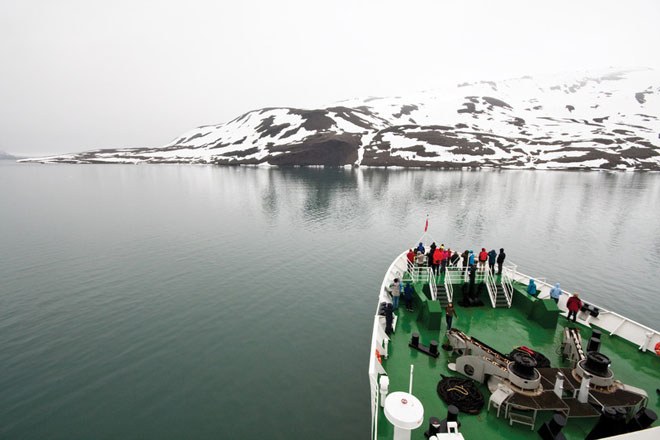
"Today started, or was it yesterday ended, in bright sunshine. Yes the midnight sun in all its glory makes it hard to go to bed when it feels like mid-afternoon. However today remained sunny until around 2pm when the Arctic sea fog moved in.
Overnight we’d sailed north into the pack ice and were lying at around 80 degrees and 550 miles from the North Pole. There was lots of ice sparkling in the sun and the morning was spent scanning with binoculars for seals and polar bears. There were both bearded and ringed seals to be spotted but not a bear in sight. Too hot? Maybe for polar bears. It was warm in the sun if you were out of the wind, but once in the shade and wind it was definitely Arctic.
When the fog drifted in, we drifted to the lounge for a lecture by the on board expert about polar bears. He seems to know all there is to know and it is gratifying to hear that the population around Svalbard in the Barents Sea has increased in recent years. This is directly attributable to the Norwegian ban on hunting them and very good news for the bears.
As the fog stayed with us it was suggested that it was the ideal time for a ‘Polar Plunge’ from the Zodiac loading bay. Hmmm, it didn’t take long to decide NOT to do it as the water temperature is around freezing. But plenty of crazy people did and an hour or more of spectator fun ensued as the brave souls jumped into the sea. A safety boat was on hand together with the ship’s photographer, and all participants had a belt on a piece of rope around their waists to be hauled out. It was said that 90 seconds was the maximum time to be in the water before the body starts to shut down. That doesn’t sound too long, but probably felt a very long time for those in the chilly water!
Later, during dinner, some blue whales were spotted off the port bow - see how the nautical lingo flows from me already - and the next hour was spent rushing from table to windows to spot these huge beasts. Mostly, only the blow was spotted with a bit of the dorsal fin but some patient photographers with mega lenses managed to record a bit more detail.
And that was about it for the day. The sea swell rose as the wind settled in and we sailed south away from the pole and back into the Barents Sea towards the north easterly islands of Sjuoyana."
Day 3 - An intriguing mix of walruses, waste disposal and historic stones...
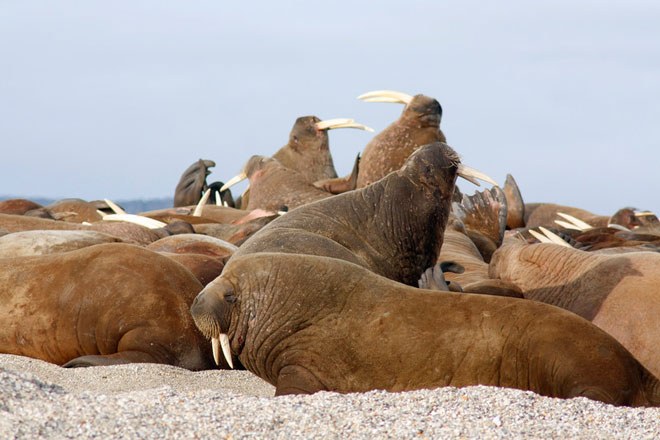
The day started as usual with the wake up announcement to all cabins at 7am - “good morning ladies and gentlemen”. It’s a bit like a holiday camp but with wonderful food, scenery and of course, wildlife. Pulling back the curtain, one is blinded by the brightness, day or night. It had been a night of rougher seas and it felt like we’d been rolling around somewhat but luckily no sea sickness.
We had arrived in the bay near Phippsoya where there is a walrus colony on one of the beaches surrounded by glacially eroded mountains. This bay is famous for Horatio Nelson having landed here as a 14 year old when he was first at sea and allegedly fought off a polar bear when he tried to go and hunt one to take the skin back to his parents.
No polar bears today so it was announced safe to go ashore. Due to the wind it was a bracing and wet Zodiac ride to the beach, observing walruses swimming along the way. Once on dry land we were able to hike around a little within the confines of the armed guides dotted about on bear alert. The focus of the morning, apart from the walruses, was to collect rubbish as the beaches collect an unbelievable amount of flotsam. Apart from a number of bleached tree trunks - from Siberia apparently - there is a disturbing quantity of plastic rubbish and our aim was to collect as much as possible. Cruises, such as ours, are doing their bit to help collect this ever increasing amount of garbage emanating from ships. Go figure (as they say in the US)!
Due to the wind, our original afternoon plan was scrapped and we were told that instead we would sail to Chermsideoya, an hour or so away and just off Nordaustland - the Svalbard Island, situated to the north east. The bay was more sheltered from the westerly wind thus enabling us to go out on the Zodiacs. Arriving there we were shuttled to shore where there are some historical sights left from various ships who used this bay as a shelter in times past. These took the form of sentences written in stones on the beach: the first in Swedish to mark the expedition which checked if the world was indeed round (in the 19th century); a swastika from the 2nd world war when the Germans used Svalbard as weather stations; and a third from the Russian ships which were searching for the Italian explorer Umberto Nobile who crashed his air ship on the way back from the North Pole.
This shore visit was brought to a hasty end when a polar bear was spotted swimming our way. Luckily or unluckily he changed course part way through the evacuation when it was too late to change plans so on returning to the ship we had a quick cup of tea and then headed back out in the Zodiacs for a cruise around the bay to look at all the beautiful glaciers - as our Zodiac driver commented ‘a geologist’s dream’.
Day 4 – Polar bears and ice floes
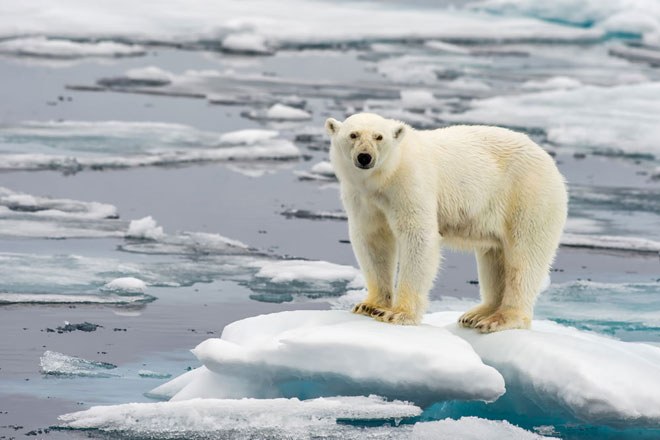
Woke up back in the ice pack at 81 degrees, the furthest north yet. Overcast but good visibility although colder at 4 degrees centigrade plus a touch windy. Brrrrrrr! Out on deck trying not to freeze but there were two polar bears to be viewed today. The first didn’t want to be seen or photographed and soon disappeared but shortly afterwards a second was spotted further north and we headed off through the ice pack to get a better sighting.
When the ship pushes through the ice the tiny arctic cod, which live just below the surface, are exposed so numerous birds follow close to us diving into the water once the ice has broken to feed. It is quite a sight and sound to break through the ice and hear it splitting beneath us. The second bear was soon spotted lying down on the ice pack - its yellow fur contrasting with the white of the ice. Once we closed in on it, it stood up and started towards the ship curious to see and smell what we were! Some great photo opportunities and the camera lenses were really out in force.
Binoculars were barely required for some time and even my rather small camera (by comparison) managed quite well. It was very special to observe the bear at such close quarters making its way over the ice flow and taking to swimming where necessary. Almost with relief he began to retreat so we left him alone and retreated inside ourselves to warm up.
It was also almost lunch time. As anyone who has been on a cruise will know the days are largely focused around meal times. The food is really good and varied although way too much can be eaten if you’re not careful. But mealtimes are a good social occasion and provide a fun get together and a chance to share wildlife stories.
In the afternoon there were lectures and entertainment planned when it was decided instead to go out on Zodiacs into the ice! WOW is probably the best word to describe the experience, at 81 degrees 39 minutes north and less than 300 miles from the pole it was quite amazing to be zipping through the remarkably still Arctic Ocean at ice level. The Zodiac drivers had a plan and soon we were driven onto an ice floe and disembarked. Probably the most northerly people in the world at that moment and to be standing on a piece of ice, well it felt very remote and potentially precarious! The guides had their guns and we kept a vigilant eye on what might be approaching but only a seal came to see what was going on. An amazing experience!
And so another action-paced day ends. We are now sailing south east towards Kvitoya (or White Island) the easternmost of the Svarlbard archipelago and 50km from Russia. This is where we will wake up tomorrow.
Day 6 - Birds, birds and more birds... plus a fox!
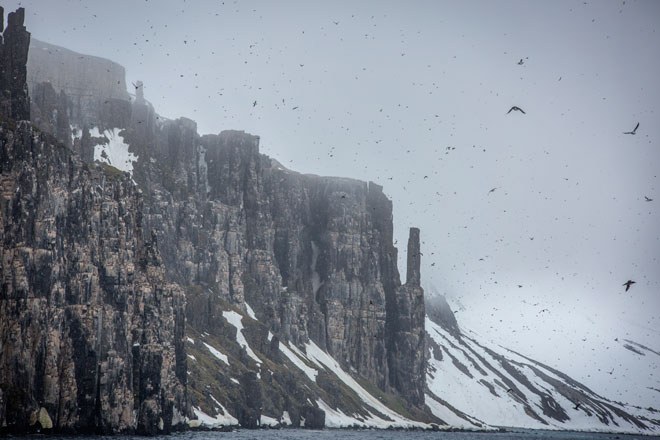
We woke to clear weather but, as we neared our anchoring point, the fog came in and the landing was off the agenda. There are never landings in fog or bad visibility for obvious reasons. Instead we were out cruising the bay in the Zodiacs, passing beneath the ice walls of the glaciers and weaving through the ice bergs and pieces drifting in the water. Every now and then a large cracking sound, like a bullet being fired, could be heard as ice calved off the glacier face into the sea. A bear was spotted lying on a large bit of ice and the Zodiacs homed in to observe the bear happily napping. A few yawns, displaying its black mouth and tongue, and the bear slid off the ice and swam off, to be seen later on land strolling along the shore. There were many walruses around swimming and lying on bits of ice together with seals bobbing around on the water and various birds – Arctic Skua, Ivory Gull, Guillemots, Arctic Terns and a flock of female Eider Ducks flying low above the water.
Mid-afternoon we arrived at Alkefjellet or Mount Guillemot which has steep dolorite cliffs rising 100 meters out of the sea. Columns have been formed by erosion and during the summer an estimated 60,000 breeding pairs of Brunnich’s Guillemots nest here. The whole experience is remarkable, the sheer volume of bird numbers, the smell and the noise – quite a spectacle. As we cruised beneath the cliffs Guillemots came sailing down, legs out-stretched towards the sea, landing and then bobbing off to fish. Adult birds perched on tiny ledges with their chicks crammed behind them waiting for the moment, after only 3 weeks, when the chick is ready to plunge into the unknown, followed by the adult male who moults and is also flightless. They then begin their long paddle south. We did see a few pairs of males plus small young beginning their journey, the chick keeping in close contact with the adult. Amongst the Guillemots there are also nesting Kittiwakes and the aggressive Glaucous gulls are hanging around ready to take advantage of any unattended eggs or young birds which they can prey upon. Further down the cliffs we also were lucky enough to see an Arctic fox in its striking summer pelt – greyish brown. This fox was making its way between boulders up the Cliffside in a less steep grassy area. These foxes make their dens around the bird breeding cliffs in the summer to feed on eggs and the young birds they find. It is important for them during this time of year to eat as much as possible ready for the lean winter months.
Back on board later that evening it was the Midnight Sun Party starting with a fancy dress competition. All good fun.
Day 7 – Ever changing scenery
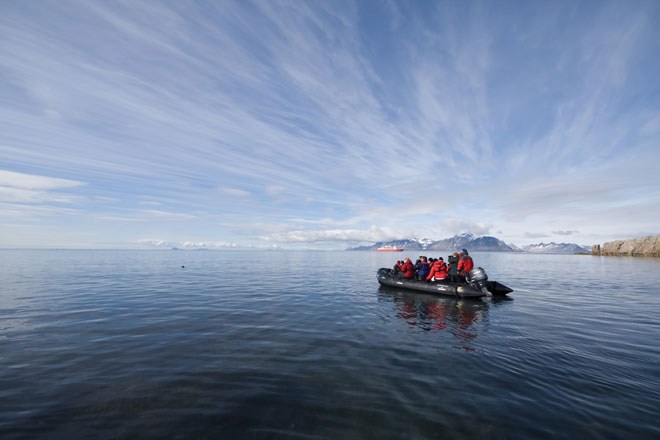
We had been told that between 5 and 7 am we would be sailing down Freemansundet to the north of Edgeoya. This area is known for its large number of polar bears who get trapped here when the ice melts and wait out the summer until winter comes. It was advised that if we wished to get up early and go on deck there was a high chance we would see bears, albeit at a distance on the land. However at 6am it was pretty cloudy so I decided the visibility was going to be too poor for much spotting. Some people who had been up at 5am did manage to see a fair number as small dots of yellowy white in the distance.
We arrived by breakfast time at Kapp Lee, a small peninsula off the north-western tip off Edgeoya. Here there was the chance to see reindeer and some old huts from when hunters would come here.It was windy and cool (7 degrees centigrade) but also lightly raining with low cloud. The Zodiac ride to land was fairly ‘bumpy’ over some biggish waves before we reached the lee of the promontory. Once on dry land we could wander around looking at the plant life, lichens, various types of saxifrage, and Arctic poppies. There were also reindeer dotted around grazing on the tough grass and plant life plus a herd of walruses hauled up on one of the small sandy beaches. It was very nice to stroll around and stretch the legs as long as we avoided the mud which, acting like quicksand, can ensnare the unvigilant walker!
Later we sailed south to Diskobukta on the west coast of Edgeoya to a landing site only available at high tide as it is surrounded by shallow water. Here you find small canyons which are breeding grounds for Black-legged kittiwakes and thus Arctic foxes who prey on the birds. Unfortunately when we arrived the sea was quite rough making getting into the Zodiacs hard and when the scouting party returned to the boat they had seen a polar bear in the bay so the excursion was off. A geology lecture was hastily arranged whilst we sailed on which was very good although I was lacking in basic knowledge to make its finer points intelligible! Instead we continued south to Russebukta a more sheltered bay where we could disembark and have a walk in the Arctic tundra. The terrain was very green with tussocks of grassy mossy land, wet and soft and plenty of plant life. There was a male reindeer to view with impressive antlers and an Arctic fox appeared busily feeding on something.
Today was quite a contrast again to previous days – it has amazed me how varied Svalbard and the Arctic areas are.
Day 8 – Glacial wonders
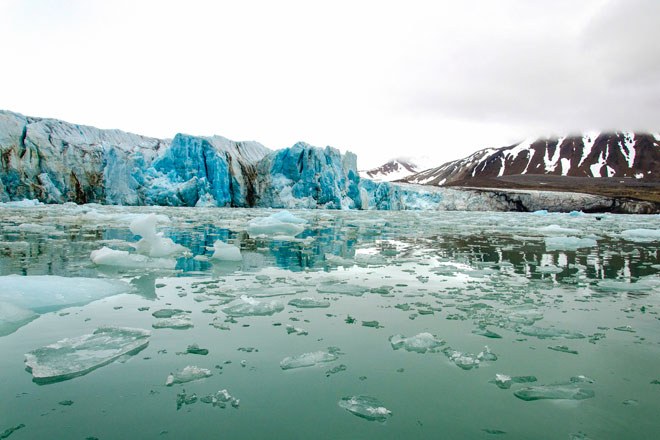
Having sailed around the southern tip of Spitzbergen overnight we woke to see Hornsund and the great glacier of Hansbreen. This was our morning’s excursion – to land beside Hansbreen and explore the area on foot. To the north of our landing was a Polish research centre comprising of a number of buildings and a ship. It suddenly felt as if we had returned to a populated area as it is the first inhabited place we have seen for a week. A short Zodiac ride took us to a beach where we disembarked and then had 2 ½ hours to wander around as we wished within the confines of the armed guides – as usual protecting the area from polar bears!
It was good to walk again and climb a short way up the mountain side to view the glacier from above. The beaches were littered with ice in varying shapes and sizes being tossed around in the waves. Every now and then a calving would occur from the glacier face and with the sound of a gun firing ice cascaded down into the water beneath forming a great spray of ice and water and a subsequent wave. During lunch we cruised deep into Hornsund right up to the face of Hornbreen and other glaciers forming the end of the fjord. From here, the afternoon Zodiac cruise took place in lovely clear weather with significant blue sky patches. The afternoon was spent cruising around amongst the icebergs and ‘bergie’ bits originating from the glacier. Numerous birds were wheeling around sourcing fish from the base of the glacier where the fresh water flowing out creates currents bringing the fish to the surface.
Small calvings occurred and suddenly a massive cracking noise and an absolutely enormous piece of ice started to fall from the face. The Zodiac drivers were quick to react and started motoring away from the glacier as the waves created by such a huge ice fall could be enough to capsize a boat and certainly make the occupants wet! Once all the excitement had died down and the water calmed we all went to examine this huge new ice berg. It was a mix of deep blue, grey, white and had striations showing the passage of air up through the ice as it is squeezed out due to the pressure within the glacier. The visible piece was estimated at 7 x 25 metres and as this is only around 10% of the total size – that’s a big berg. The staff reckoned it was the biggest calving they had witnessed and were pretty excited by it too.
Later in the evening we had an on deck BBQ surrounded by the glaciers and icebergs before setting sail once more heading back towards Longyearbyn for our final day at sea. What an adventure it's been.
If you'd love to have your own Arctic adventure then take a look at our collection of Polar cruises: